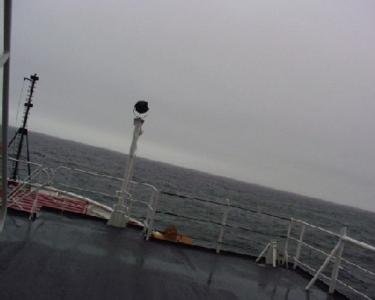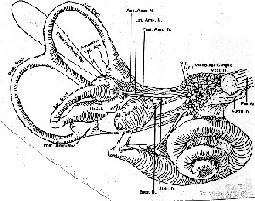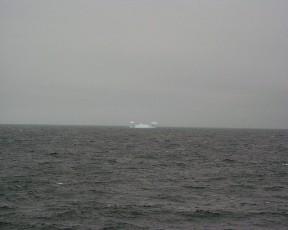28 May, 2000
Rockiní and Rolliní in the Deep Blue Labrador Sea
Doing science on a ship isnít that easy. One of the biggest challenges
scientists on the Healy face is that the ship is always moving. Sometimes
the ship tips forward and back over the waves. This is called the pitch. At
the same time, the ship is rocking from side to side. This is called the
shipís roll.
The ship has a special instrument called a clinometer for measuring pitch
and roll. The clinometers are mounted on the wall on the shipís bridge,
which is where the captain navigates the ship. The way they work is really
quite simple. A hollow glass tube is filled with a liquid that is dyed red
so it is easy to see. A large air bubble floats in the liquid. As the ship
rolls from side to side, the air bubble also moves in the liquid. Carpenters
use the same kind of tool to make sure a board is straight. Do you know what
the carpenterís tool is called?
Pitch and roll are measured in degrees of an angle. Look at the two
clinometers in the picture. The glass tubes are curved. If you continued
following the curve to the other end of the tube, you would have a circle.
Do you know how many degrees are in a circle?
Pitch and roll are also responsible for that queasy feeling some people get
when they travel on ships. Inside your ear is a tube filled with fluid. The
fluid in your ear moves the same way the fluid in the clinometer moves. It
sends a message to your brain telling it whether you are standing still or
moving. Your brain also gets messages from your eyes.
To the right is a diagram of the inside of your ear.
Can you see the tubes where fluid might be?
Try this: stand as still as you can. The fluid in your ears will stop
moving. Now look around you. The objects in the room arenít moving either.
Both your ears and your eyes tell your brain that you are standing still.
Now imagine standing still on a ship. Even though you arenít moving your
muscles, your body is still moving because the ship is pitching and rolling.
This causes the fluid in your ears to slosh around. So your ears tell your
brain that your body is moving. Your eyes, however, just see what is in the
room around you. It looks like nothing is moving, so your eyes tell your
brain that you are standing still. The conflicting messages confuse your
brain. The result is that you feel dizzy and nauseous. Many people have to
take medicine so that they wonít feel seasick.
To find out how pitch and roll affect daily life on the ship, click on
Janice's page.
Janice's Entry
Today.
DAILY DATA LOG (5/28/00):
47 degrees F
Latitude 48N
Longitude 48W
Sunrise 4:35 a.m.
Sunset 8:32 p.m.
ANSWERS TO QUESTIONS:
The carpenterís tool used to make sure boards are straight is called a
level.
There are 360 degrees in a circle.




Here is the first iceberg we saw. It's on the center of the horizon. Can you see it? It looked big, but it looks pretty small in this picture.
Contact the TEA in the field at
.
If you cannot connect through your browser, copy the
TEA's e-mail address in the "To:" line of
your favorite e-mail package.
|
